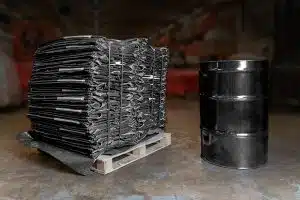 Selecting the right waste storage container is one of the most important decisions for any facility that handles hazardous or chemical waste. The container must not only meet regulatory standards but also match the specific characteristics of the waste being stored. Choosing incorrectly can lead to leaks, environmental contamination, or safety violations.
Selecting the right waste storage container is one of the most important decisions for any facility that handles hazardous or chemical waste. The container must not only meet regulatory standards but also match the specific characteristics of the waste being stored. Choosing incorrectly can lead to leaks, environmental contamination, or safety violations.
Whether you’re managing industrial waste, chemical byproducts, or contaminated materials, the right container can make a significant difference in safety, efficiency, and compliance. Gorilla Drum provides durable, compliant solutions for managing hazardous waste effectively and sustainably.
Understanding the Importance of Proper Waste Containers
Hazardous waste comes in many forms—liquids, solids, sludges, or mixed materials. Each type requires a container designed to withstand its chemical and physical properties. The wrong drum or container could corrode, weaken, or fail under pressure, leading to dangerous spills or costly cleanups.
Proper waste storage also helps maintain compliance with Environmental Protection Agency (EPA) and Department of Transportation (DOT) regulations. Using UN rated hazmat drums and DOT approved hazmat containers ensures that waste remains safely contained during handling, transport, and disposal.
Factors to Consider When Choosing the Right Container
Type and Classification of Waste
The first consideration is the type of waste being stored. Understanding its classification determines the material, construction, and certification level of the container.
-
Liquids: Require leakproof, corrosion-resistant containers such as plastic or composite drums.
-
Solids and sludge: Often need open-head containers for easier loading and removal.
-
Flammable or reactive waste: Should be stored in metal drums designed to handle pressure and prevent ignition.
Knowing whether the material is corrosive, toxic, reactive, or ignitable will guide your selection of the appropriate hazardous waste drum.
Container Material
Different materials offer distinct advantages based on chemical compatibility.
-
Steel drums are ideal for flammable or high-temperature materials but can corrode when exposed to acids or certain chemicals.
-
Plastic or polyethylene drums resist corrosion and are better for storing acids, alkalis, and water-based waste.
-
Composite containers combine both materials, offering durability and chemical resistance.
A 55 gallon hazmat drum is one of the most common choices for industrial and chemical applications, but the material should always match the waste properties.
UN and DOT Certification
Compliance is non-negotiable when handling hazardous materials. Containers must meet specific performance standards for strength, leakproofness, and durability.
-
UN rated hazmat drums are tested under international standards to ensure they can safely contain hazardous materials.
-
DOT approved hazmat containers meet U.S. transportation requirements for shipping hazardous waste on public roads.
Before selecting a container, verify that it carries the correct markings and certifications for your specific waste type.
Size and Capacity
Container size plays a major role in storage efficiency and cost. While the 55 gallon hazmat drum remains a standard for most operations, smaller or larger containers may be more practical depending on waste generation rates.
Key considerations include:
-
Total volume of waste produced per cycle
-
Available storage space
-
Frequency of disposal or pickup
Overfilled containers can cause leaks, while underutilized space increases costs. Selecting the correct capacity ensures safety and efficiency.
Compatibility and Corrosion Resistance
Every chemical reacts differently with storage materials. Before placing waste into a container, confirm that the drum material is compatible with the chemical composition of the waste.
For instance, acids and caustics require non-reactive plastic containers, while petroleum products are best stored in steel drums. Failure to ensure compatibility may result in corrosion, structural failure, or hazardous reactions.
Handling and Transport Requirements
The container must also suit your facility’s handling and transport systems. Consider how drums will be moved, lifted, and loaded. Lightweight containers with built-in lift loops or dolly straps, such as those offered by Gorilla Drum, improve worker safety and efficiency.
For offsite transport, make sure containers meet DOT specifications and are properly sealed, labeled, and secured.
Space and Storage Conditions
Facility layout and storage environment are important considerations when selecting waste containers. Drums must be stored in stable, well-ventilated areas away from heat or ignition sources. If space is limited, collapsible hazmat storage drums can help reduce the storage footprint while maintaining compliance and safety.
Proper secondary containment, such as spill pallets or berms, should also be used to capture potential leaks or spills.
Environmental and Sustainability Goals
Many organizations are moving toward more sustainable waste management practices. Reusable and recyclable containers can reduce waste generation and overall disposal costs. Choosing long-lasting materials such as polypropylene, used in Gorilla Drum containers, supports environmental goals while maintaining compliance with safety regulations.
Common Types of Waste Storage Containers
-
Closed-head drums: For liquids and hazardous materials requiring tight seals.
-
Open-head drums: For solids, sludges, or materials that need easier access.
-
Composite containers: Combine materials for added strength and chemical resistance.
-
Collapsible containers: Ideal for space-saving storage and return shipping.
Each container type serves a specific purpose and must be matched to the waste characteristics to ensure safe and compliant storage.
Importance of Regular Inspection and Maintenance
Even the best containers require ongoing inspection. Regularly checking for leaks, corrosion, bulging, or label wear helps maintain compliance and prevents accidents. Containers that show signs of damage should be replaced immediately.
Keeping accurate records of inspections and maintenance activities also supports compliance during environmental audits or inspections.
Choosing the Right Container with Confidence
Selecting the appropriate waste storage container can be complex, especially when dealing with multiple waste streams or strict regulatory requirements. To simplify the process, refer to the Guide To Choosing The Right Hazmat Drums For Waste Storage. This resource provides detailed information on materials, testing standards, and selection criteria to help you make informed decisions.
Gorilla Drum: Safe, Compliant, and Efficient
Gorilla Drum offers an innovative alternative to traditional chemical barrel and hazmat barrel containers. Engineered from high-strength polypropylene, these drums are UN and DOT compliant, lightweight, and collapsible for efficient storage and transport.
Their reinforced design allows for the safe containment of both hazardous liquids and solids, while their compact form reduces storage costs. Gorilla Drum provides reliability, compliance, and environmental responsibility all in one solution.
Final Thoughts
Choosing the right waste storage container requires balancing safety, compliance, and practicality. From material compatibility to handling needs, every factor plays a role in protecting workers, the environment, and your bottom line.
Gorilla Drum provides industry-leading solutions designed to simplify hazardous waste storage while meeting all UN and DOT regulations.
To learn more about choosing the right container for your operation, call +1 800-758-8079.

